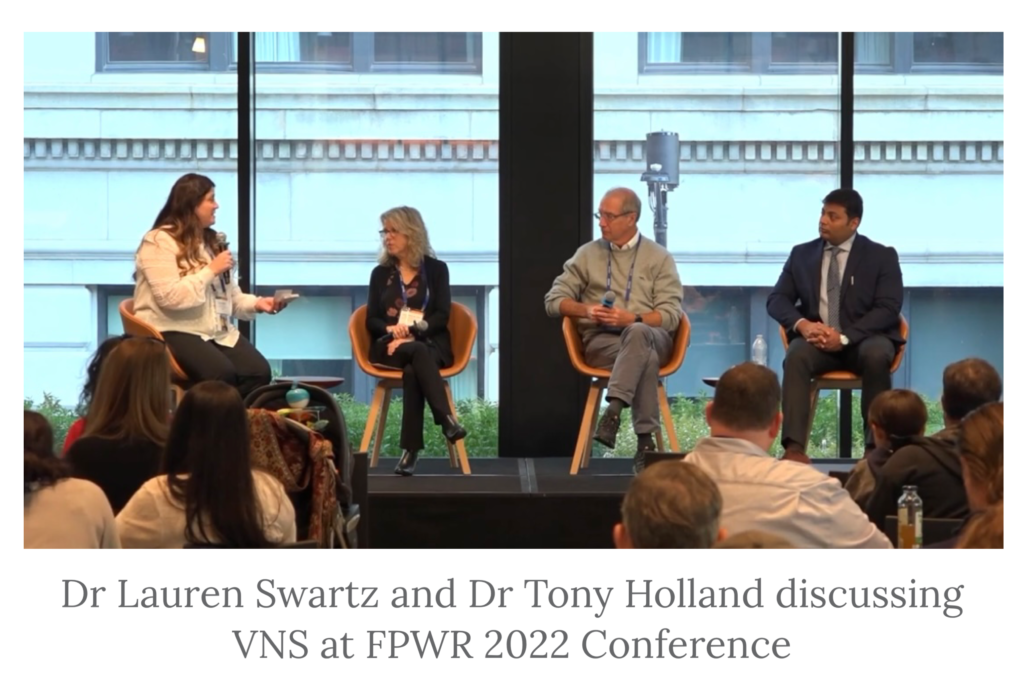
You may have seen posts or articles about VNS, but what exactly is it? VNS stands for Vagus Nerve Stimulation, and it is an exciting, potential new way to help with temper outbursts in PWS.
We all have a Vagus Nerve which runs from our brain and extends down into the stomach area. The nerve has lots of branches that come off it which led to other organs in the body such as the heart and lungs. Dr Lauren Schwartz at the 2022 FPWR Conference nicely described the Vagus Nerve as ‘mind/body highway’ as it sends fast messages around the body and allows us to have instant reactions to things and also helps to control our emotions. The Vagus Nerve is also involved in kick starting our body’s ‘fight or flight’ response which helps us to respond to danger This is very important in actual dangerous situations but can also be triggered by other situations which aren’t actually dangerous to us but causes a physical or emotion response. This can happen with PWS, which could explain why something that we might perceive as a small thing, such as a change of routine for instance, could be a big deal for someone with PWS. This change is disrupting the usual balance of things and the fight or flight system is put into action in error which can lead to what we might term a tantrum or a meltdown.
It is hoped that by stimulating the Vagus Nerve that this bodily system can be regulated and calmed, and create the balance needed to respond to situations calmly and rationally, and hopefully avoid leading to a meltdown or distress.
How was VNS discovered as a treatment for PWS?
VNS has been around for a while and has been used in other conditions such as depression and epilepsy. It is an approved treatment with a good safety rate but hasn’t been on the PWS radar, until now.
Dr Tony Holland, a Psychiatrist from Cambridge University in the UK, started out by investigating VNS as a potential treatment for hunger in PWS. One of the many jobs of the Vagus Nerve is being a part of the message to the brain from the stomach to say “I’m full”, which we all know in PWS is a message that often does not get there. Unfortunately the small study he did didn’t show improvements in hunger, but did transform the behaviour of the participants. Two out of the three original people who sampled the VNS device had typical PWS behaviour issues before using the device, and afterwards they became much calmer.
One lady in the original study became much calmer and went on to get married. She commented how through the use of VNS she was much more able to cope with the stresses of her wedding and then deal with adapting to married life. Her mother also commented that one day they were in a rush and she tentatively suggested to her daughter with PWS that they had their lunch at home rather than out as planned. She said she was shocked when her daughter just said yes and agreed that that was fine. Previously before the VNS device use this would have caused distress for her as it would have thrown her plans (and her body and emotions) out of sync.
What does using VNS actually entail?
The original study involved an implanted VNS device that had to be added surgically. However the next study they did (and the proposed future study) involved an external device that is about the size of a mobile phone, which can be attached to the arm (like a runner would with their phone). There is then a wire leading from the device with a clip that clips behind the ear and from there it stimulates the Vagus Nerve. The device needs to be activate for around four hours a day, but the way that the device can be worn should mean that it won’t disrupt most daily activities and participants can carry on as normal.
Dr Holland and Dr Schwartz do both warn not to trust VNS devices that can be purchased online. The ones that they are using for the studies are tested and accurate, whereas ‘off the peg’ ones might not be effective.
Could VNS do more than help with temper outbursts?
The original idea of testing VNS with PWS was to help with hunger and unfortunately this did not help. However it is important to remember that the studies that have taken place so far are very small and on the wider, larger study we might find more promising results in this area. Dr Tony Holland commented at the 2022 FPWR Conference that he is optimistic that the newer studies will show improvements beyond temper control. A definite glimmer of extra hope here is from how caregivers in the original VNS studies have said how much more reasonable their person with PWS was after using the devices. They were able to discuss their diet and access to food more calmly, and were more willing to accept changes to their food routine. This is hopefully promising beyond behaviour and emotions (which are concerning areas themselves) and into the food and diet side of PWS. It is currently not known, but it’s possible and exciting, and is a big reason why the wider testing of VNS in the PWS Community is so important.
What happens now?
The previous two studies into VNS have been very small, with only three participants in the first study and five in the second. Whilst the results from both of these studies were exciting and promising, a larger study needs to be done in order to get VNS approved for use in PWS.
Our sister charity FPWR in the USA are prioritising the VNS study and have already reached their first stage in fundraising, which means that the devices needed can be purchased. They need to continue to raise funds to be able to fully set up the study and recruit participants, which they are aiming to do next year (2023).
To take part, the current guidelines are that the person has PWS and must already suffer from temper outbursts. They are aiming at recruiting participants aged between 10 and 40. Younger people with PWS also can suffer with temper outburst but the reason behind the age 10 starting point was that most typical children would no longer have temper outbursts by this age, so if the person with PWS is having this issue it is most likely caused by PWS.
The study is likely to run for around a year, as it does take some time initially to see the effects from the VNS device. The initial part of the study is likely to involve an in person visit to the clinician running the study in a particular area and then the study can be conducted remotely/from home.
To run the study they will need lots of participants and are hoping to set up clinics across America but also want to expand out globally, which will hopefully include the UK. The initial studies were here and Dr Tony Holland is based here so it would be wonderful to have a UK clinic. For that we will need to raise funding which is why FPWR UK has taken the decision to offer its fundraisers and donors the choice to either put any money they send to FPWR UK into the wider fund, which will still go to funding exciting world class research projects, or to ask for their donations to go directly into VNS research.
We are at an exciting point in this potentially life changing research. Temper and emotional outbursts are a huge disruption to people with PWS and to their families. To find a way to help that, and to also see the possible other benefits that VNS could have, such as more flexibility around food plans and diet, is taking a huge leap into making the lives of those with PWS much easier.
